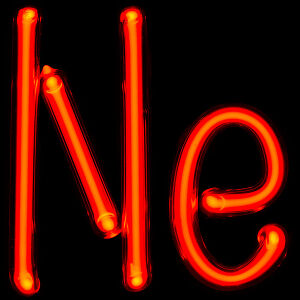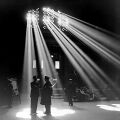Neon lighting (nonfiction): Difference between revisions
No edit summary |
No edit summary |
||
| Line 7: | Line 7: | ||
The color of the light depends on the gas in the tube. Neon lights were named for neon, a noble gas which gives off a popular orange light, but other gases and chemicals are used to produce other colors, such as hydrogen (red), helium (yellow), carbon dioxide (white), and mercury (blue). | The color of the light depends on the gas in the tube. Neon lights were named for neon, a noble gas which gives off a popular orange light, but other gases and chemicals are used to produce other colors, such as hydrogen (red), helium (yellow), carbon dioxide (white), and mercury (blue). | ||
Neon tubes can be fabricated in curving artistic shapes, to form letters or pictures. They are mainly used to make dramatic, multicolored glowing signage for advertising, called neon signs. | Neon tubes can be fabricated in curving artistic shapes, to form letters or pictures. They are mainly used to make dramatic, multicolored glowing signage for advertising, called [[Neon sign (nonfiction)|neon signs]]. | ||
The term can also refer to the miniature neon glow lamp, developed in 1917, about seven years after neon tube lighting. While neon tube lights are typically meters long, the neon lamps can be less than one centimeter in length and glow much more dimly than the tube lights. They are still in use as small indicator lights. Through the 1970s, neon glow lamps were widely used for numerical displays in electronics, for small decorative lamps, and as signal processing devices in circuity. While these lamps are now antiques, the technology of the neon glow lamp developed into contemporary plasma displays and televisions. | The term can also refer to the miniature neon glow lamp, developed in 1917, about seven years after neon tube lighting. While neon tube lights are typically meters long, the neon lamps can be less than one centimeter in length and glow much more dimly than the tube lights. They are still in use as small indicator lights. Through the 1970s, neon glow lamps were widely used for numerical displays in electronics, for small decorative lamps, and as signal processing devices in circuity. While these lamps are now antiques, the technology of the neon glow lamp developed into contemporary plasma displays and televisions. | ||
| Line 28: | Line 28: | ||
== Fiction cross-reference == | == Fiction cross-reference == | ||
* [[Crimes against light]] | |||
* [[Gnomon algorithm]] | |||
* [[Gnomon Chronicles]] | |||
== Nonfiction cross-reference == | == Nonfiction cross-reference == | ||
| Line 33: | Line 37: | ||
* [[Georges Claude (nonfiction)]] | * [[Georges Claude (nonfiction)]] | ||
* [[Light (nonfiction)]] | * [[Light (nonfiction)]] | ||
* [[Neon sign (nonfiction)]] | |||
* [[William Ramsay (nonfiction)]] | * [[William Ramsay (nonfiction)]] | ||
* [[Morris Travers (nonfiction)]] | * [[Morris Travers (nonfiction)]] | ||
| Line 43: | Line 48: | ||
[[Category:Nonfiction (nonfiction)]] | [[Category:Nonfiction (nonfiction)]] | ||
[[Category:Light (nonfiction)]] | [[Category:Light (nonfiction)]] | ||
[[Category:Neon (nonfiction)]] | |||
Latest revision as of 08:13, 4 October 2019
Neon lighting consists of brightly glowing, electrified glass tubes or bulbs that contain rarefied neon or other gases.
Neon lights are a type of cold cathode gas-discharge light. A neon tube light is a sealed glass tube with a metal electrode at each end, filled with one of a number of gases at low pressure.
A high potential of several thousand volts applied to the electrodes ionizes the gas in the tube, causing it to emit colored light.
The color of the light depends on the gas in the tube. Neon lights were named for neon, a noble gas which gives off a popular orange light, but other gases and chemicals are used to produce other colors, such as hydrogen (red), helium (yellow), carbon dioxide (white), and mercury (blue).
Neon tubes can be fabricated in curving artistic shapes, to form letters or pictures. They are mainly used to make dramatic, multicolored glowing signage for advertising, called neon signs.
The term can also refer to the miniature neon glow lamp, developed in 1917, about seven years after neon tube lighting. While neon tube lights are typically meters long, the neon lamps can be less than one centimeter in length and glow much more dimly than the tube lights. They are still in use as small indicator lights. Through the 1970s, neon glow lamps were widely used for numerical displays in electronics, for small decorative lamps, and as signal processing devices in circuity. While these lamps are now antiques, the technology of the neon glow lamp developed into contemporary plasma displays and televisions.
Neon was discovered in 1898 by the British scientists William Ramsay and Morris W. Travers. After obtaining pure neon from the atmosphere, they explored its properties using an "electrical gas-discharge" tube that was similar to the tubes used for neon signs today.
Georges Claude, a French engineer and inventor, presented neon tube lighting in essentially its modern form at the Paris Motor Show from December 3–18, 1910. Claude, sometimes called "the Edison of France", had a near monopoly on the new technology, which became very popular for signage and displays in the period 1920-1940. Neon lighting was an important cultural phenomenon in the United States in that era; by 1940, the downtowns of nearly every city in the US were bright with neon signage, and Times Square in New York City was known worldwide for its neon extravagances.
The popularity, intricacy, and scale of neon signage for advertising declined in the U.S. following the Second World War (1939–1945), but development continued vigorously in Japan, Iran, and some other countries.
In recent decades architects and artists, in addition to sign designers, have again adopted neon tube lighting as a component in their works.
Neon lighting is closely related to fluorescent lighting, which developed about 25 years after neon tube lighting. In fluorescent lights, the light emitted by rarefied gases within a tube is used exclusively to excite fluorescent materials that coat the tube, which then shine with their own colors that become the tube's visible, usually white, glow. Fluorescent coatings and glasses are also an option for neon tube lighting, but are usually selected to obtain bright colors.
In the News
Sunlight praises neon lighting for innovative conversion of electricity into light.
Fiction cross-reference
Nonfiction cross-reference
- Georges Claude (nonfiction)
- Light (nonfiction)
- Neon sign (nonfiction)
- William Ramsay (nonfiction)
- Morris Travers (nonfiction)
External links:
- Neon lighting @ Wikipedia

